Charles Manson, with Eastern Kentucky roots, remains a pop culture icon phenomenon as we acknowledge the 50-year anniversary of the actress Sharon Tate and other murders on August 9, 1969.
Manson’s bizarre sick life captured the mind of the nation during a tumultuous period in the United States. He was able to hang out with Dennis Wilson who was the Beach Boys’ drummer, have his song recorded by the Beach Boys and others, have rock stars adopt his name, and have President Richard Nixon call him out during the Manson trial. He gained a new generation of interested persons when the Guns N Roses song played their 1993 cover of Manson’s song Look At You’re Game Girl from their covers album “The Spaghetti Incident?.”
Manson is being introduced to a new generation as Hollywood releases movies on the anniversary of the killing spree in California. The Quentin Tarantino film “Once Upon a Time in Hollywood” includes the Sharon Tate murder and Manson as a backdrop to another Hollywood story featuring Brad Pitt and Leonardo DiCaprio.
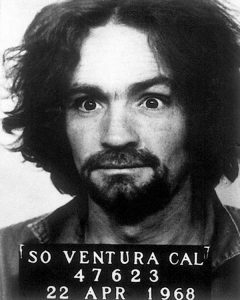
Like others in my generation, I became curious about how this man could gather a group of people he called his family and have them kill others for demented reasons. Little did I know that later I would interact with him and find out through a letter about his early life. Being the editor and publisher of the Troublesome Creek Times the weekly newspaper in Knott County, a historian, and an autograph collector, I wrote to Manson when I had been told he spent some time in Knott County.
As you read the letter below keep in mind how focused he remained in his writing about this part of his life. I have read dozens of his letters in autograph journals. There is usually a psychotic break in which he goes off on a tangent including Hitlerism or his spiritual claims. Since Manson was born in November 1934 and his mother did not get out of prison until 1942, it is likely he was around 8 to 10 years old when he was in Knott County.
In response to a September 1993 letter to Charles Manson in prison concerning being in Knott County and being around the Blue Moon Café he wrote, “Mom worked there after she got out of prison. I was 5 or 6…law and order border town (he draws smiley face)….moon was in jars then. Now I got it under my fingers. My grandmoms brother was put in prison and hung for a murder in Knocksville. I think that in TENN. Its been a long time since I ever thought. Its TRUE you cant take the Hills out of the boy. I think I left my diper pens in Eddieville (draws prison). I remember the VISITING room and I was just walking and my uncle was rolling an old Indian Bike – BIKER BOOTS in them days….WERE Railroad boots.
“I stomped all over Ky. I got 1000s of snake cousins who fear saying oh yes Manson is related to all the Raymes, Millers, Kilkores, Mc’s and Mac Irish and Satts moonshiners and mason jars (signed Charles Manson) ps. I still ant went to no YANKEE School.”
The Blue Moon Café no longer stands on the top of Jones Fork Mountain off KY 550. At the time Manson was in the vicinity Knott County was “wet” allowing legal alcohol sales. I was told by area residents that adjacent to the café were “Ginny Barns” in which women and men could have privacy. Most written accounts describe Manson’s mom, Kathleen, as a prostitute which may explain her purpose at the place. In a 1972 interview she denied she was ever a prostitute. The building later used for other purposes, once including mission work in distributing clothes.
Last year one elderly man hearing about my Manson letter told me, “I played with Charlie as a kid…he was meaner than a snake.”
The biographies of Manson omit the period of years 1943 to 1947 when his mother sent him away. Manson wrote in a memoir in 1987, Manson In His Own Words, about his troubled youth. He was born to a single mother, abandoned at the age of 12 and then abused and raped at reform school.
“It’s obvious there is something lacking in my makeup,” Manson said. He also reflected on his popular image as the face of evil. “I’m nothing but the reflection of evil that goes through the minds of all those people who created the monster and keep pushing the myth to kids who don’t know any better,” he wrote.
Manson said in one interview that the most poignant childhood moment in his life was when his mother gave him a hug after getting out of prison. He was obviously starved for his mother’s love and attention after being sent off to relatives during her incarceration. But, his relationship with her was complicated as stated in one interview. “Mom was in a cafe one afternoon with me on her lap. The waitress, a would-be mother without a child of her own, jokingly told my Mom she’d buy me from her. Mom replied, ‘A pitcher of beer and he’s yours.’ .it off and left the place without me. Several days later my uncle had to search the town for the waitress and take me home.”
When Manson’s mother was sent to a West Virginia prison he went to live with his mother’s sister Glenna and her husband Bill in the same state. The uncle was not happy having “Charlie” around. In his first few days of school, a notoriously cruel teacher ridiculed Charles for being the son of a criminal, and he returned home with tears streaming down his face. His uncle Bill yelled that crying was only for girls and forced him to return to school in a girl’s dress the next day as punishment.
His mother was born Ada Kathleen Maddox to her parents Charles and Nancy in Rowan County, Kentucky. The family moved to Ashland when Kathleen was 10. She became pregnant with Colonel Scott of Catlettsburg, Kentucky at the age of 16. Kathleen married a William Manson while she was pregnant. Charles was born in a Cincinnati hospital.
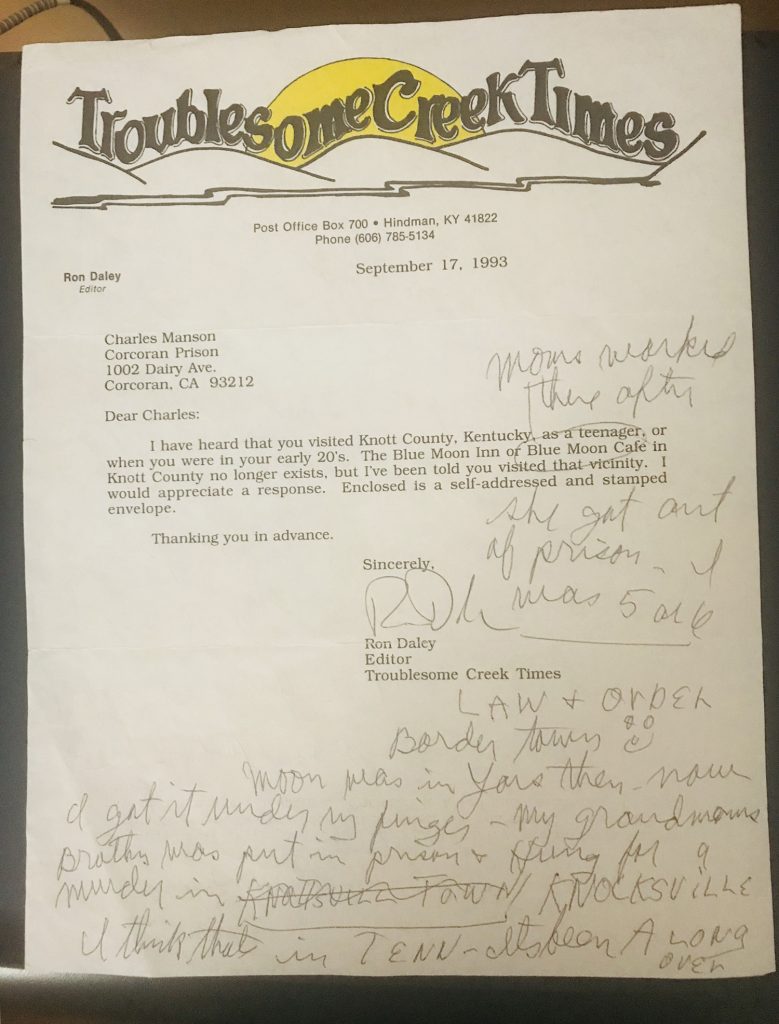
The letter I received from Manson demonstrated the fear he evoked decades after his imprisonment. I did not receive my letter directly from Manson in 1993. I was glancing through an autograph auction catalogue in March 1996 and saw a listing of several Manson letters, one of which was about his time in Knott County. The dealer faxed the letter, and to my surprise, it had my Times letterhead which Manson had replied on the front and back. When the dealer refused to let me have my letter which I told him I never received, I contacted the state newspapers. The articles written by them were picked up by the Associated Press and published across the nation including on many front pages. I ended up getting my letter after paying him $100.
Two members of my staff became alarmed and frightened when people from out of state called our newspaper office and warned that Manson could have his followers come and harm us. This was nearly three decades after the murders.
I was also amazed how many young people were familiar with Manson.
However, I learned that the Guns N Roses Manson 1993 song had brought attention to a new generation.
So how is it that this scrawny 5’ 4” troubled man, Prisoner No B-33920 evoked so much terror and has captured our imagination for decades? Manson was correct to a certain degree that the media was a reason. The Rolling Stones Magazine published on June 25, 1970 “Charles Manson: The Incredible Story of the Most Dangerous Man Alive.
A chilling, deeply investigative look into the terrifying Manson family – including a jailhouse interview with Charlie himself,” enhanced his fame.
Then, during the Manson trial, The Los Angeles Times published the grisly (and since recanted) confession of Susan Atkins, one of Manson’s followers.
During the trial Manson held up a newspaper with the heading “Manson Guilty, Nixon Declares” and forced a temporary halt in testimony at the Tate murder trial.

Nixon made the comment during a press conference criticizing the press, saying that it tends to “glorify and to make heroes out of those who engage in criminal activities.” Referring to the Manson case, Nixon said, “here is a man who was guilty, directly or indirectly, of eight murders without reason.” Nixon said that “as far as the coverage was concerned [Manson] appeared to be rather a glamorous figure.”
The trial with sensational, too, framing the murders in late 60’s time of social upheaval, talk of revolution, the hippie movement, anti-war sentiment, drugs, sex and rock and roll.
The public learned that Manson ordered the murders to start a race war in which he thought blacks would have done earlier. In his demented state he thought the Beatles song “Helter Skelter” on their White Album was a call to this war. The song is supposedly about an English amusement ride. The lyrics are:
When I get to the bottom
I go back to the top of the slide
An’ I stop, an’ I turn, an’ I go for a ride
Til I get to the bottom
An’ I see you again
Yeh
Do you, don’t you, want me to love you?
I’m comin’ down fast, but I’m miles above you
Tell me, tell me, tell me
Come on, tell me the answer
Well, you may be a lover but you ain’t no dancer
Lookout
Helter Skelter
Helter Skelter
Helter Skelter, Yeh
So even the Beatles were brought into the trial. John Lennon was asked to testify at Manson’s trial but refused saying, “Well he’s barmy. He’s like any other Beatles kind of fan who reads mysticism into it. I mean we used to have a laugh putting this, or the other in, in a light-hearted way. Some intellectual would read us, some symbolic youth generation wants it, but what’s “Helter Skelter” got to do with knifing somebody? I never listened to the words properly. It was just noise.”
The killings taking place in Hollywood, a center of media, and the wall scrawlings in blood of “Death to pigs”, and the misspelled “Healter Skealter” – produced lurid headlines in California and elsewhere.
Most experts conclude it was Manson’s heavy drug use and failure to become successful in music as the cause for him to have the psychotic break leading to the murders. He desperately wanted the Beach Boys to do his music, but Dennis Wilson was unable to get the group to do Manson’ songs.

He requested his parole office be moved to California so he could follow his musical career.
Manson released two albums from prison, LIE and Live at San Quentin. Guns N’ Roses and Marilyn Manson, whose stage name was in part inspired by Manson, recorded songs he wrote.
Manson did have a magnetic personality as an adult and used it to build his family. He acted as a spiritual leader while being able to get young women to have sex with him and others.
Dennis Wilson let Manson’ group stay at his place for a while until they become too much of nuisance, costing him much money. Dennis was initially fascinated by Manson and his followers, referring to him as “the Wizard” in a Rave magazine article. In September 1968, Dennis recorded a Manson song for the Beach Boys, originally titled “Cease to Exist” but reworked as “Never Learn Not to Love” as a single B-side released the following December. It was credited solely to Dennis angering Manson.
It was a summer night in 1968 when Dennis and two friends took Manson to the famous Los Angeles Whiskey, a Go-Go. They witnessed Manson’s magnetic ability. They had witnessed his charm in small gatherings before. However, when Manson moved onto the dance floor in his hippie attire amongst the elite of the city’s society and stars, they moved back and watched him dance. Music producer Greg Jakobson stated, “Anytime Charlie wanted to be the center of attention, he could be. At the Whiskey, they had thought they had seen it all. “Until that night they saw Charlie.”
Jakobson was called as witness in the Manson trial. As part of his testimony, he said in 1969 that Manson was a different person from when he knew him in 1968. Manson was much thinner and looked like a wild animal after it had been caged. He acknowledged that Manson would at times think of himself as Christ; at other times the devil.
When asked about Manson’s personality when he first met him in 1968, Jakobson testified, “He was like a friendly puppy dog, that’s as close as I can come. That’s why he was so well-liked.”
That change that occurred in Charles Manson from 1968 to 1969 destroyed lives while the media sensationalized the acts of a broken, evil and sick man bringing him the fame he so desired.
Ron Daley is the strategic partner lead for the Kentucky Valley Educational Cooperative (KVEC), a consortium of 22 school districts. A resident of Eastern Kentucky for 44 years, he now resides in Lexington.











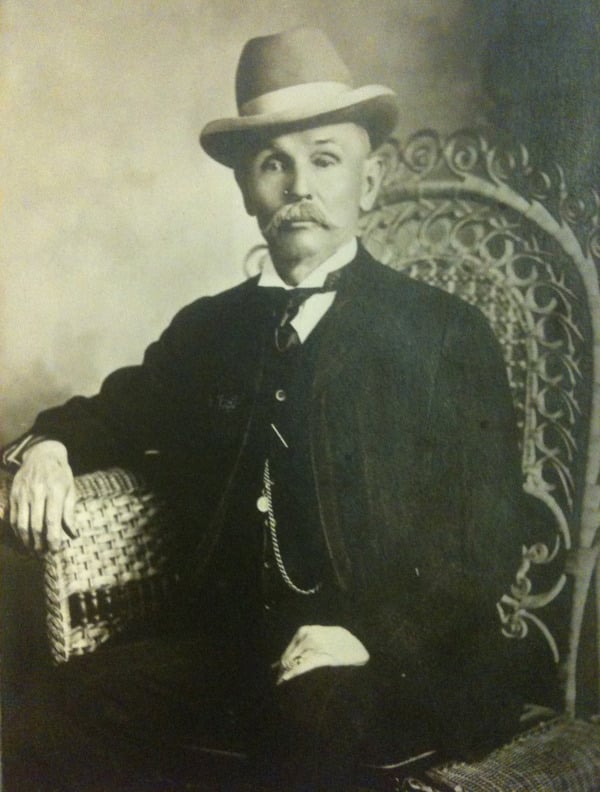
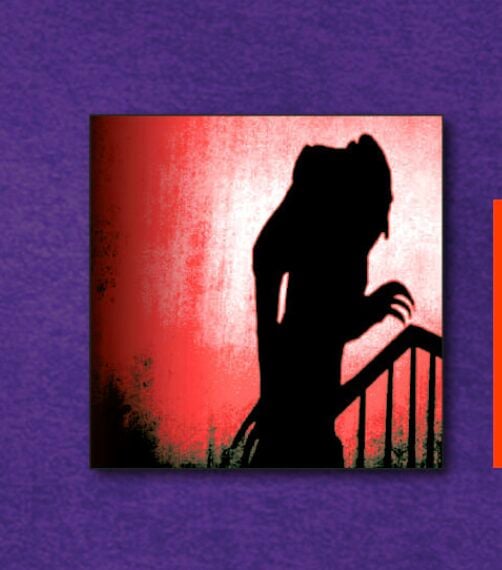
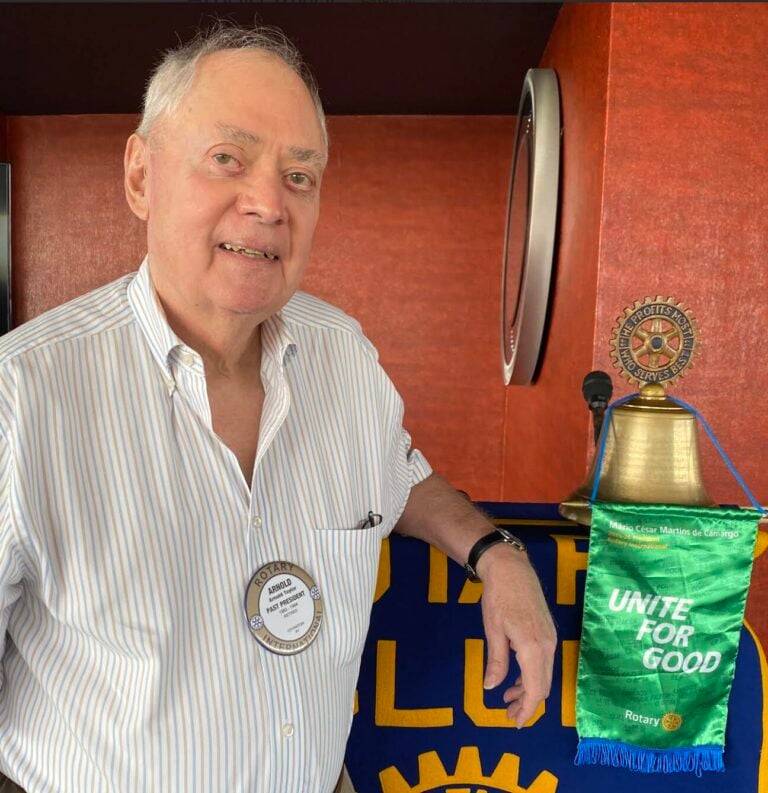

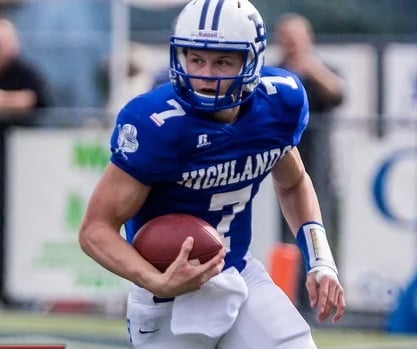


The building is at 5491 (Approx) Hwy 550 Near Leburn in Knott County. Sits on top of a hill. Cant miss it.
I’d love to visit Charles Mansons home in knott county Ky. Can you give me the address to this place ? Thanks
It’s in Hindman Ky on highway 550 at the top of the hill. Still looks the same as in the articles.Visited it last night…